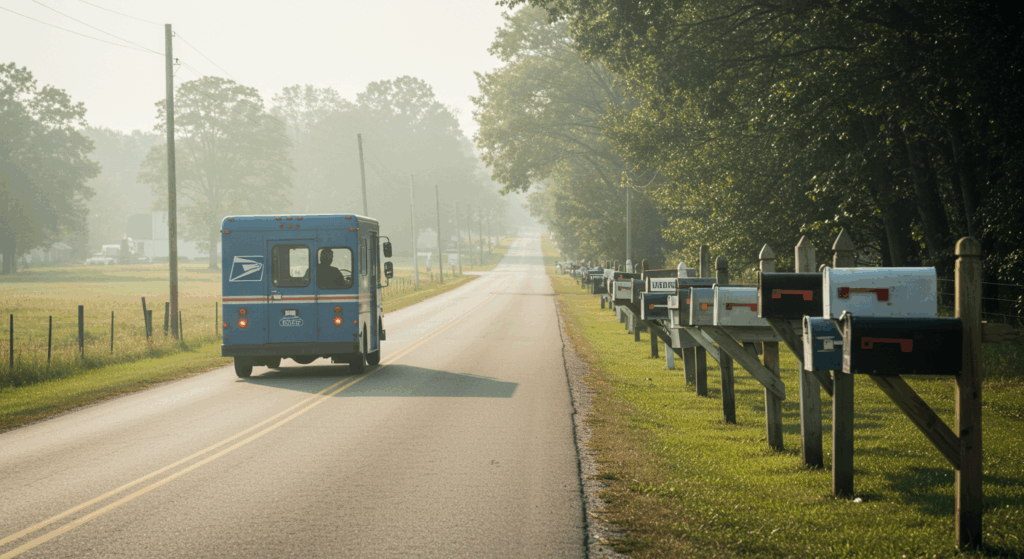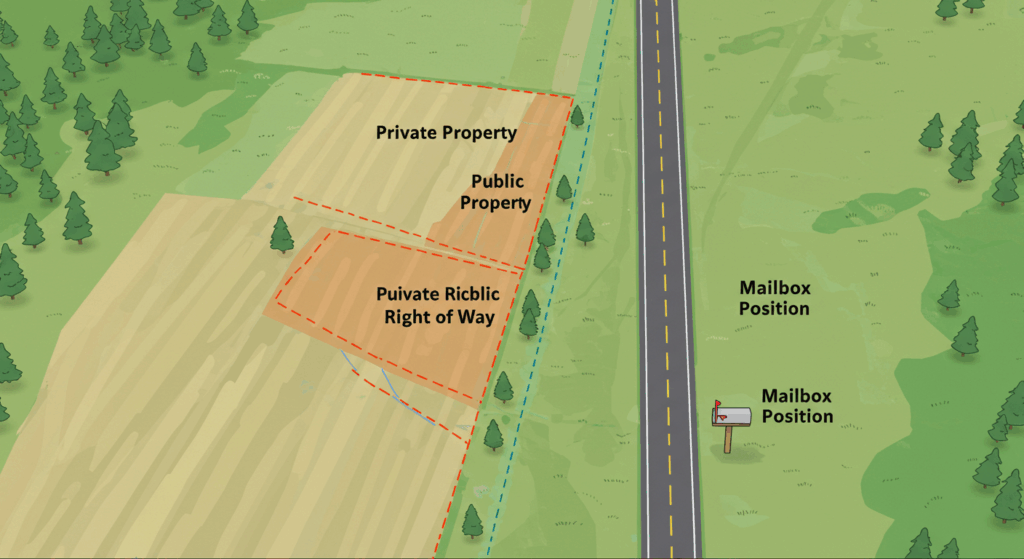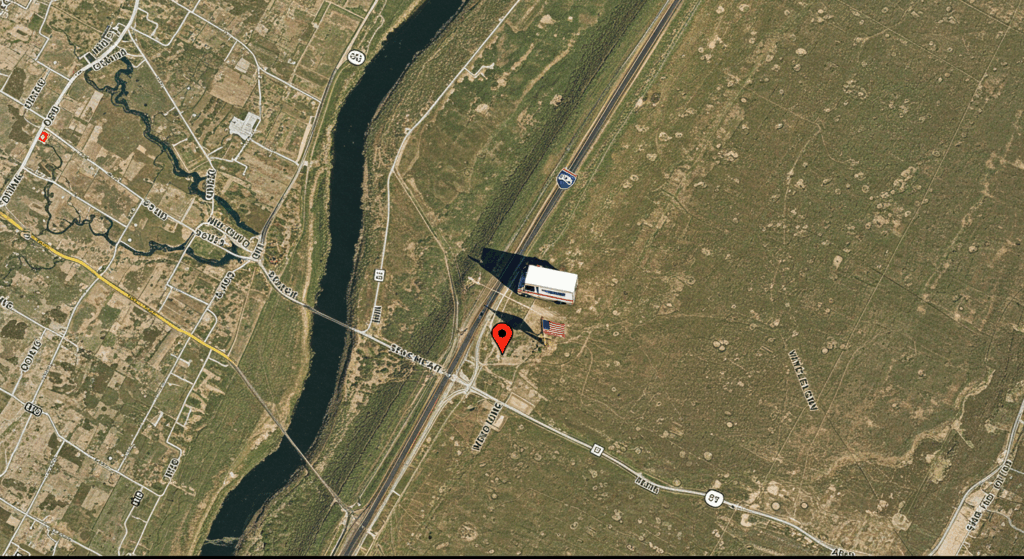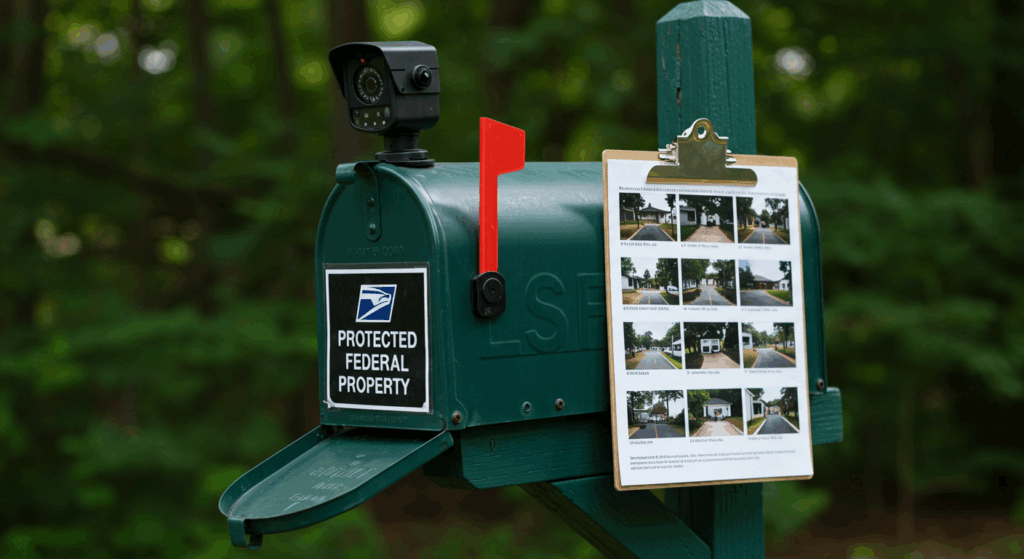A developer told a rural houseowner to move their mailbox to make way for a new subdivision entrance — even though it violated USPS delivery routes and posed real safety risks. This houseowner didn’t back down. Learn how to defend your rights in a mailbox relocation dispute.
- 1. When a Mailbox Becomes a Battlefield
- 2. What a Normal Mailbox Setup Should Look Like
- 3. When the Builder Steps In
- 4. Is It Even Legal for Them to Ask?
- 5. Why I Went to the Post Office — And What Happened
- 6. What the Postmaster Told Me (and What You Should Know)
- 7. How to Document and Protect Your Mailbox
- 8. What I Learned — and What You Should Do If It Happens to You
1. When a Mailbox Becomes a Battlefield
It started like any normal morning. I was sipping my coffee when I heard a knock at the door. A man in a neon vest was standing on my porch, holding a clipboard. He looked official enough. He said they were preparing to break ground on a new subdivision right across the road. That part wasn’t a surprise — we’d seen the signs and survey flags.
What was a surprise was the next thing he said.
“We’re going to need you to move your mailbox. It’s in the way of the new entrance.”
He said it like it was no big deal. But it was a very big deal.
I live in rural Ohio, and like everyone else around here, our mailbox is across the street — on the opposite side of a narrow two-lane road with no sidewalk, no shoulder, and a steep ditch. It’s always been that way. That’s where the USPS delivers. That’s where the mail truck goes.
The builder didn’t seem interested in any of that. He just wanted my mailbox gone.
When I asked him where he expected me to move it to, he said:
“Just move it to your side. Shouldn’t be a problem.”
Here’s the problem:
There is no space on my side of the road. There’s a steep ditch. There’s no shoulder.
I’d have to walk over 75 feet in either direction from my driveway just to find a spot to put the box — and that’s after walking 400 feet from my front door.
Not to mention: the road is on a blind curve.
We’ve had drivers hit our mailbox twice over the years — it’s not a safe place to be walking.
And it’s not just about convenience. My mailbox is how I get prescription meds. Official documents. Social Security notices. Moving it, or making it inaccessible, isn’t just annoying. It’s life-impacting.
And yet, a private developer — who doesn’t own the land the mailbox sits on — was telling me to move it because it was “in their way.”
That’s when I realized:
This wasn’t about a mailbox.
This was about power.

2. What a Normal Mailbox Setup Should Look Like
2.1 Why Are Mailboxes Usually Across the Road?
In many rural parts of America, mailbox placement follows a very specific logic — but few people ever question it until there’s a conflict. For decades, the USPS has delivered mail in a one-sided route format. That means homes on both sides of the road often receive mail only on one designated side.
“Mailboxes must be placed so that carriers can deliver mail without leaving their vehicles.”
— USPS Delivery Guidelines, Section 631.2
The goal is simple: safety and efficiency. Mail carriers don’t cross traffic, don’t make U-turns, and never get out of the truck. That’s especially important on narrow two-lane roads with ditches and no shoulders — like the one I live on.
This system has worked well for years. USPS routes are meticulously planned to minimize stops, reduce risk, and increase speed.
And that’s exactly why my mailbox, and nearly every mailbox on this stretch of road, is across the street. That’s the way it’s always been — and for good reason.
2.2 My Mailbox Was in Full Compliance
When the builder said I could “just move it to my side,” I realized he didn’t understand the delivery route at all. He assumed any spot in front of a house would work.
But my side of the road has no flat ground, no safe shoulder, and a steep drainage ditch. There is no way a USPS truck could safely or legally stop there.
And even if I wanted to walk 75 feet in either direction to make space for a new mailbox — on top of the 400-foot walk from my front door — I’d still be violating USPS placement guidelines.
“Mailboxes should be installed on the right-hand side of the road in the carrier’s direction of travel.”
— USPS Handbook PO-603
My mailbox had been in the same place for years, delivering prescriptions, tax documents, and Social Security letters. It wasn’t broken. It didn’t violate any rule. It was exactly where it was supposed to be.
2.3 The System They Tried to Ignore
The builder’s request wasn’t just a nuisance. It showed a complete disregard for how federal delivery logistics work. USPS isn’t just a convenience — it’s a federal service with infrastructure-level regulations.
It’s not something a builder can change just because it’s “in the way.”
USPS Rural Mailbox Placement Rules
| Rule | USPS Guideline |
|---|---|
| Placement Side | One side of the road only, following mail route |
| Carrier Access | Must be reachable without exiting the vehicle |
| Height & Distance | 6 to 8 inches from the edge of the road |
| Road Type | Designed for narrow rural two-lane roads |

3. When the Builder Steps In
3.1 The First Contact
The first time I spoke to anyone from the developer’s team, I didn’t expect conflict. I thought it would be a courtesy notice — maybe informing me about construction dates or equipment deliveries. But instead, I was told my mailbox was “in the way.”
“We’re putting in a turn lane and some landscaping. The mailbox will need to be relocated.”
No apology. No room for discussion. Just a stated fact — as if it were a done deal.
The man had no uniform, no badge, and gave no official notice. He had a clipboard and a sense of authority that didn’t match the facts.
When I asked, “Where should I move it?” he waved his hand vaguely toward my side of the road.
“Just somewhere over there. That’s your property, right?”
3.2 What They Didn’t Understand — or Pretended Not To
What he didn’t seem to grasp was that the mailbox wasn’t on their property — and it wasn’t on mine either. It sat in the public right-of-way, where the USPS had long established a delivery route. Neither of us had the authority to dictate its placement. Only the postmaster does.
The builder also didn’t seem to care about safety or accessibility. My side of the road had no safe shoulder, no place for a mail truck to pull over, and it was on a dangerous curve. And yet, they wanted me to just figure it out.
They didn’t ask. They told.
They didn’t suggest. They insisted.
And what they insisted on violated USPS policies, basic logic, and common decency.
“We’ll have to remove it when the equipment comes through,” he said.
Like it was an obstacle. Like it was trash.
3.3 The Pressure Behind the Politeness
Developers often use a soft tone with hard consequences.
They speak as if they’re being reasonable, while implying they’ll move forward with or without you. That’s exactly what happened here.
They wanted the appearance of cooperation — but not the reality of it.
There was no formal letter, no hearing, no review.
Just verbal pressure.
And when I refused to move the mailbox on my own, they said:
“Then we’ll talk to the post office.”
As if that settled it.

4. Is It Even Legal for Them to Ask?
4.1 Understanding Who Owns What
Before getting into whether a developer can demand you move a mailbox, we have to understand where the mailbox actually sits.
In most rural areas, mailboxes are placed on the public right-of-way (ROW) — the strip of land adjacent to the road, owned or controlled by a government authority, typically the county or township. This area is designated for public use, including utilities, drainage, and yes — postal delivery.
“Mailbox placement and relocation are determined solely by the United States Postal Service.”
— USPS Domestic Mail Manual, Section 508
So even though the land may appear to be part of someone’s private property, it isn’t. And unless a developer owns the actual right-of-way (which is exceedingly rare), they have no legal authority over what’s placed there.
4.2 What the Law Actually Says
Mailbox placement in the U.S. is governed by both federal postal regulations and local traffic safety rules. Here’s what matters:
- USPS governs where a mailbox can go.
- Local government governs what’s allowed near a public road.
- Private developers govern nothing unless they legally own both the road and the ROW.
“Federal law prohibits the obstruction, destruction, or unauthorized relocation of mailboxes.”
— U.S. Code Title 18, Section 1705
This means:
✔️ USPS decides mailbox locations
✔️ Only the postmaster can approve changes
✔️ Anyone else who moves or removes a mailbox — including a developer — may be committing a federal offense
4.3 How Developers Use Assumptions as Leverage
The builder I spoke to was clearly operating under assumptions:
- That I wouldn’t know the law
- That the mailbox was “on my land”
- That USPS would go along with their version of the story
This is how leverage works in small-town developments.
Builders bet on confusion, compliance, and convenience. They hope residents won’t push back.
But here’s the truth:
Your mailbox is a federal installation.
It’s not a planter. It’s not a lawn ornament.
And it can’t be moved just because it blocks landscaping.
Who Has Authority Over Your Mailbox?
| Entity | Legal Authority Over Mailbox |
|---|---|
| United States Postal Service (USPS) | ✅ Full authority to approve, relocate, or deny placement |
| County or Township Government | ✅ Controls road access and right-of-way zoning |
| Homeowner | ❌ Cannot relocate without USPS approval |
| Developer | ❌ Has no authority unless they own the ROW (rare) |

5. Why I Went to the Post Office — And What Happened
5.1 When Talking to the Builder Fails
After my third conversation with the builder — all of which ended with some version of “we’ll move it if you don’t” — I knew this wasn’t going to resolve through friendly discussion.
I needed to find out who actually had the final word.
And I knew exactly where to go: the post office.
Not the website. Not the customer service line.
I needed to speak to someone who actually understood the route, the regulations, and the layout of my road.
“Can I speak to the postmaster, please?”
It was the first thing I asked when I walked into the post office lobby.
At first, I was met with some confusion. The clerk said it was “probably a zoning issue” or “something for the county.”
I expected that.
So I came prepared.
5.2 The Power of Showing, Not Just Telling
Before I left home, I printed out a satellite image of our road from Google Maps.
It was clear, high-resolution — and it just so happened to show the USPS mail truck delivering directly to my box.
“I swear, the timing was unbelievable. The satellite shot literally had the truck there, at my mailbox.”
I also brought photos of the ditch, the curve, and the lack of any safe area on my side of the road.
I highlighted the mailbox on the map, marked distances from my house, and attached a note:
“Developer wants this moved. No safe alternative exists.”
The clerk’s face changed.
She walked into the back to speak with the postmaster.
5.3 What the Postmaster Said
A few minutes later, the postmaster came out.
He thanked me for the visuals and said — yes — the builder had contacted them.
But the builder had described a different stretch of the road, closer to town, where houses exist on both sides and mailboxes are installed accordingly.
“That area’s been mixed for years,” he explained.
“But we never deliver on both sides out here. And we’re not changing that now.”
He said he would “look into it formally” but made it clear:
“That suggestion won’t work. The builder’s request is not acceptable.”
He also thanked me for bringing proof.
That part mattered more than I realized.

6. What the Postmaster Told Me (and What You Should Know)
6.1 The Real Reason USPS Said “No”
When the postmaster stepped into the lobby, he didn’t come out with hesitation.
He came out with clarity.
“We don’t deliver on both sides of that road. Never have.”
“And based on what you showed me, there’s no safe or logical alternative.”
He confirmed that the builder had misrepresented the location — possibly to make their request seem more reasonable. But the postmaster saw through it immediately.
He explained that USPS had a long-standing route for our area, optimized for efficiency and safety, and that no change would be made unless USPS itself determined it was necessary.
“We operate based on logistics and delivery safety — not developer preferences.”
6.2 What Most People Don’t Realize
The postmaster also told me something that I believe every houseowner should hear:
“People think mailboxes are theirs to move, but they’re not. Once you install it, and we start delivering — that’s part of the USPS route. And we protect that route.”
He said they routinely receive complaints from people who don’t understand this.
From neighbors who think they can shift boxes for landscaping, from builders who don’t want them visible from the entrance.
But once the delivery pattern is set, it becomes part of federal infrastructure.
Not a decoration. Not private property.
“That box is a federal access point. It’s not negotiable.”
6.3 The Role of the Postmaster (and Why You Should Talk to Them)
Many people assume postmasters are unreachable — or that their job is administrative.
But in reality, the local postmaster is the final authority on how mail is routed in your area.
They don’t answer phones all day.
They’re managing carriers, routes, breakdowns, complaints — and legal compliance.
“Don’t come first thing in the morning,” the clerk told me later.
“Wait until after the trucks are out. That’s when they’ll talk to you.”
The postmaster is not just a manager.
In disputes like this, they are the law.
Common Misunderstandings vs USPS Reality
| Misunderstanding | Actual USPS Policy |
|---|---|
| “I can move my mailbox wherever I want.” | Mailbox placement must be approved by USPS and match delivery routes. |
| “If it’s on my property, I control it.” | Mailboxes on the ROW are federally regulated, not private structures. |
| “The developer can ask for changes.” | Only USPS and the postmaster can authorize mailbox relocation. |
| “If it’s in the way, I can remove it.” | Unauthorized removal of a mailbox is a federal crime. |

7. How to Document and Protect Your Mailbox
7.1 Why Documentation Matters
If you’re facing pressure to move your mailbox — whether from a builder, neighbor, or even a local official — the first thing you must do is start a paper trail.
In any federal service dispute, the party with documentation always wins.
What counts as documentation?
- Photos of the current mailbox placement
- Notes on past mail deliveries (dates, time, who delivered)
- Any letters or verbal statements from those pressuring you
- A record of all conversations, including dates and times
- Copies of USPS policies or communications
“Once you can show the system has worked, the burden shifts to whoever wants to change it.”
— Advice from a former mail carrier
7.2 Use Cameras — and Make It Obvious
If you suspect your mailbox might be moved or tampered with, install a visible camera facing the road.
Federal law makes it a crime to tamper with a mailbox.
But the burden of proof is on you if it happens.
“Mailbox vandalism or unauthorized removal is a federal offense under Title 18, Section 1705 of the U.S. Code.”
This means you can and should:
✔️ Install a camera with a wide angle on the box
✔️ Post a small sign saying “Surveillance in Progress”
✔️ Keep footage backed up in case of disputes
You don’t need to hide your concern — make it clear you’re watching.
7.3 Notify USPS and the Postmaster in Writing
Verbal complaints are forgettable. Written records are not.
If you anticipate conflict, or if someone threatens to move the mailbox, write a formal letter or email to the local post office.
Include:
- Your full name and address
- A description of the threat or interference
- Any photographic or video evidence
- A copy of any communication from the builder
“Include a sentence like: ‘I am concerned that someone may attempt to move, damage, or remove this federally protected mailbox without authorization.’”
Once that letter is in their hands, they’re required to document it internally — which protects you.
How to Protect Your Mailbox

8. What I Learned — and What You Should Do If It Happens to You
8.1 This Was Never Just About a Mailbox
Looking back, the mailbox was just the symbol.
The real issue was power, boundaries, and who gets to say what happens to your space.
A private developer tried to assert control over public space.
They relied on confusion and compliance.
But they were wrong — and the postmaster confirmed it.
I didn’t win because I shouted the loudest.
I won because I documented, asked questions, and took it seriously.
“Just move it” sounds simple.
But nothing about this was simple.
8.2 Your Property Rights Begin With Knowing the System
You can’t defend what you don’t understand.
And too often, houseowners assume USPS is flexible or informal. It’s not.
Mailbox placement follows specific federal logistics.
Once it’s established, it’s protected.
If someone asks you to move it — pause, document, and verify with USPS.
Because if you agree to a change without USPS approval, you become the violator, not them.
“Your mailbox is a federally protected delivery point. Don’t let anyone treat it like lawn decor.”
8.3 If You’re Ever in This Situation: Follow This Checklist
Whether the pressure is from a developer, a new neighbor, or local zoning confusion — here’s exactly what to do:
Mailbox Conflict Survival Checklist
| Step | Action |
|---|---|
| 1. Stop the conversation | Do not agree verbally to anything. Say you’ll check with USPS. |
| 2. Document everything | Take photos, note threats or requests, save messages. |
| 3. Visit your post office | Ask for the postmaster. Bring visuals. Be clear. |
| 4. Follow up in writing | Send a written notice to USPS describing your concern. |
| 5. Monitor your mailbox | Use cameras or a log to ensure no one tampers with it. |
8.4 What Insurance Can Help in a Case Like This
When conflict escalates over something on or near your property — even a mailbox — the right insurance coverage can be the difference between peace of mind and expensive consequences.
Let’s break down the policies that matter here.
Relevant Insurance Coverage for Mailbox & Property Disputes
| Insurance Type | What It Covers | Why It’s Relevant |
|---|---|---|
| Homeowners Insurance | Covers damage to permanent structures, including mailbox posts if declared. | If a contractor damages your mailbox or related landscaping. |
| Umbrella Liability Insurance | Adds legal defense coverage beyond your home policy limit. | If disputes escalate to court or you’re falsely accused of obstruction. |
| Service Line Coverage (Optional) | Protects underground lines like water, sewer, or electric near the mailbox. | If the builder’s excavation damages hidden lines under your easement. |
“Don’t wait until something breaks or ends up in court.
Know what’s covered, and what’s not — before you need to file a claim.”

